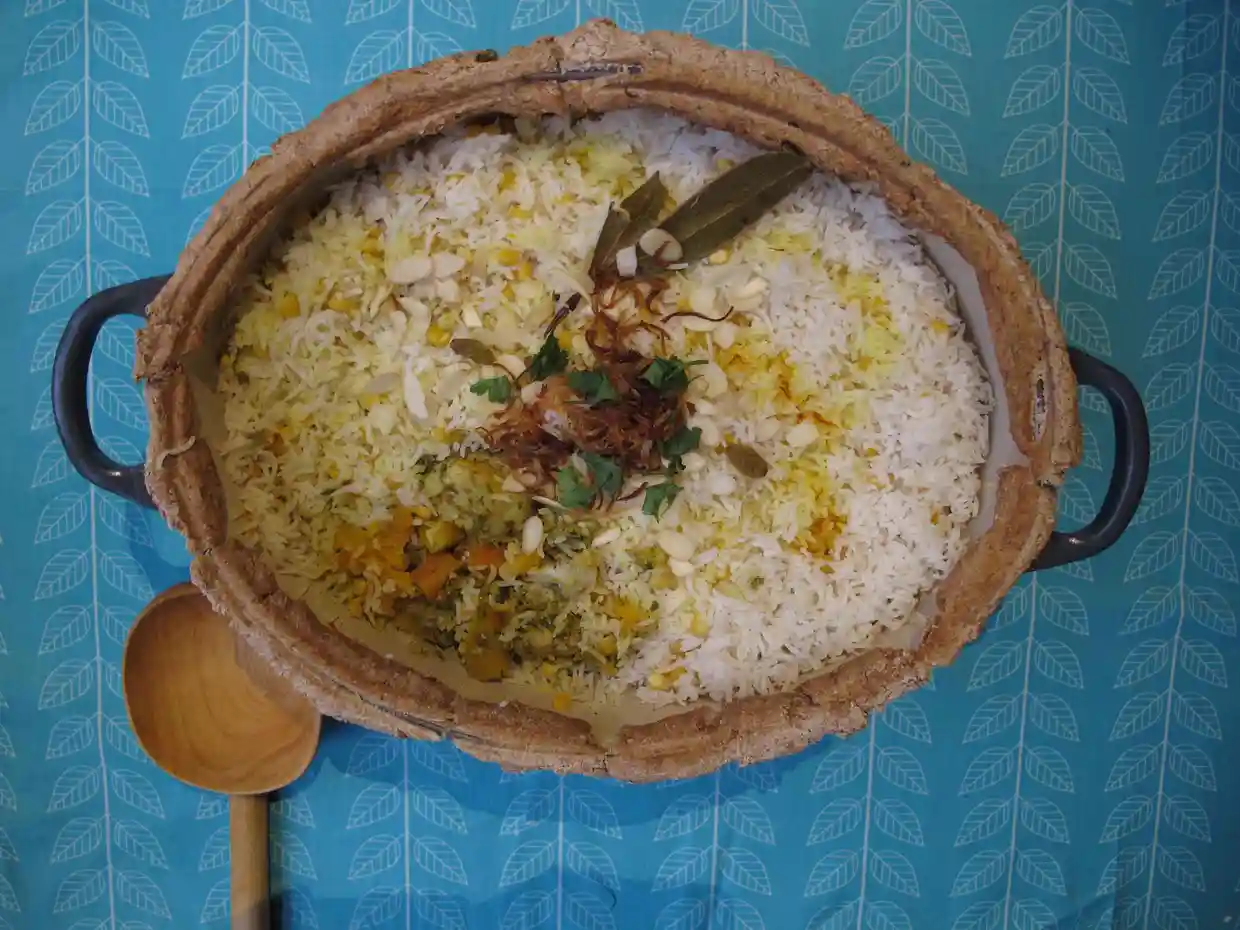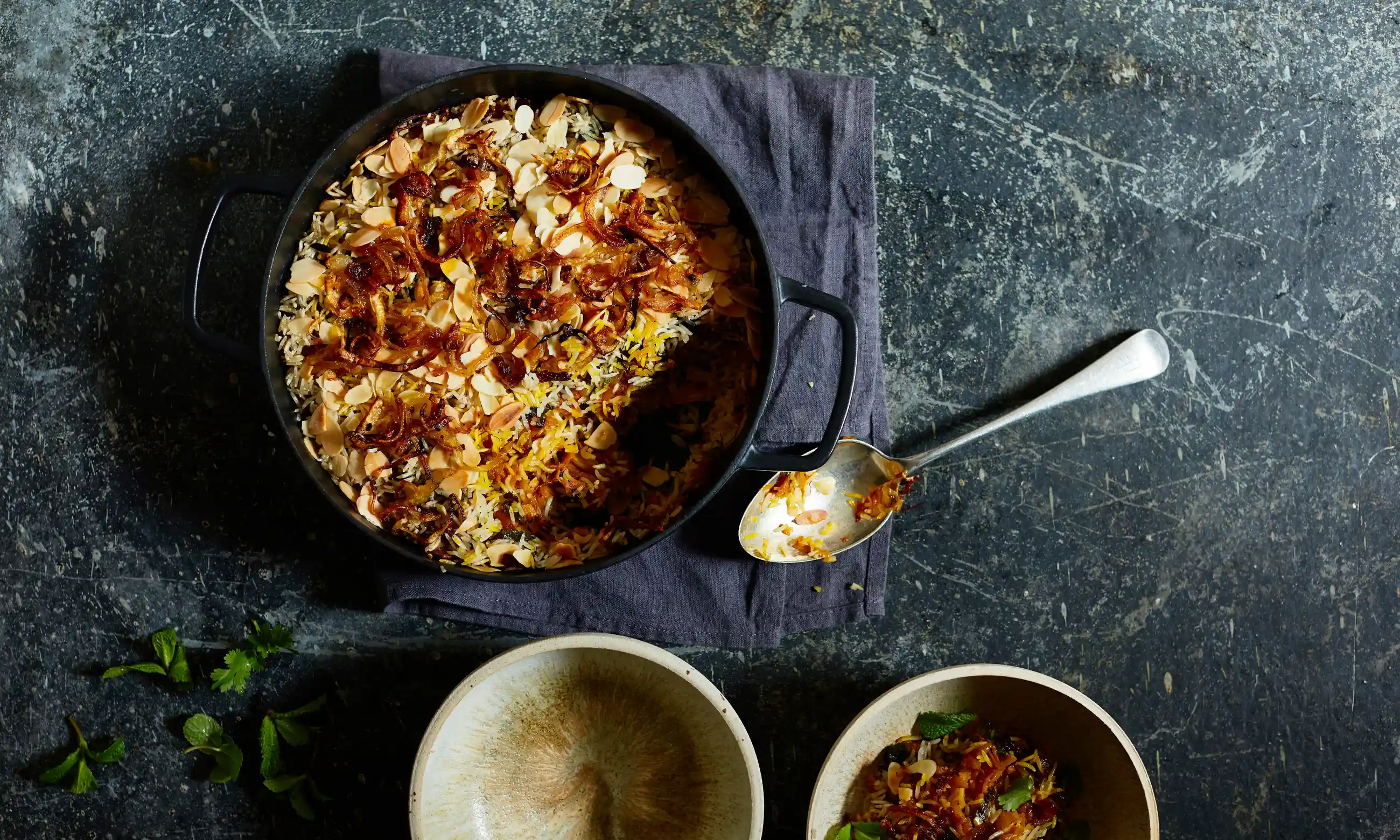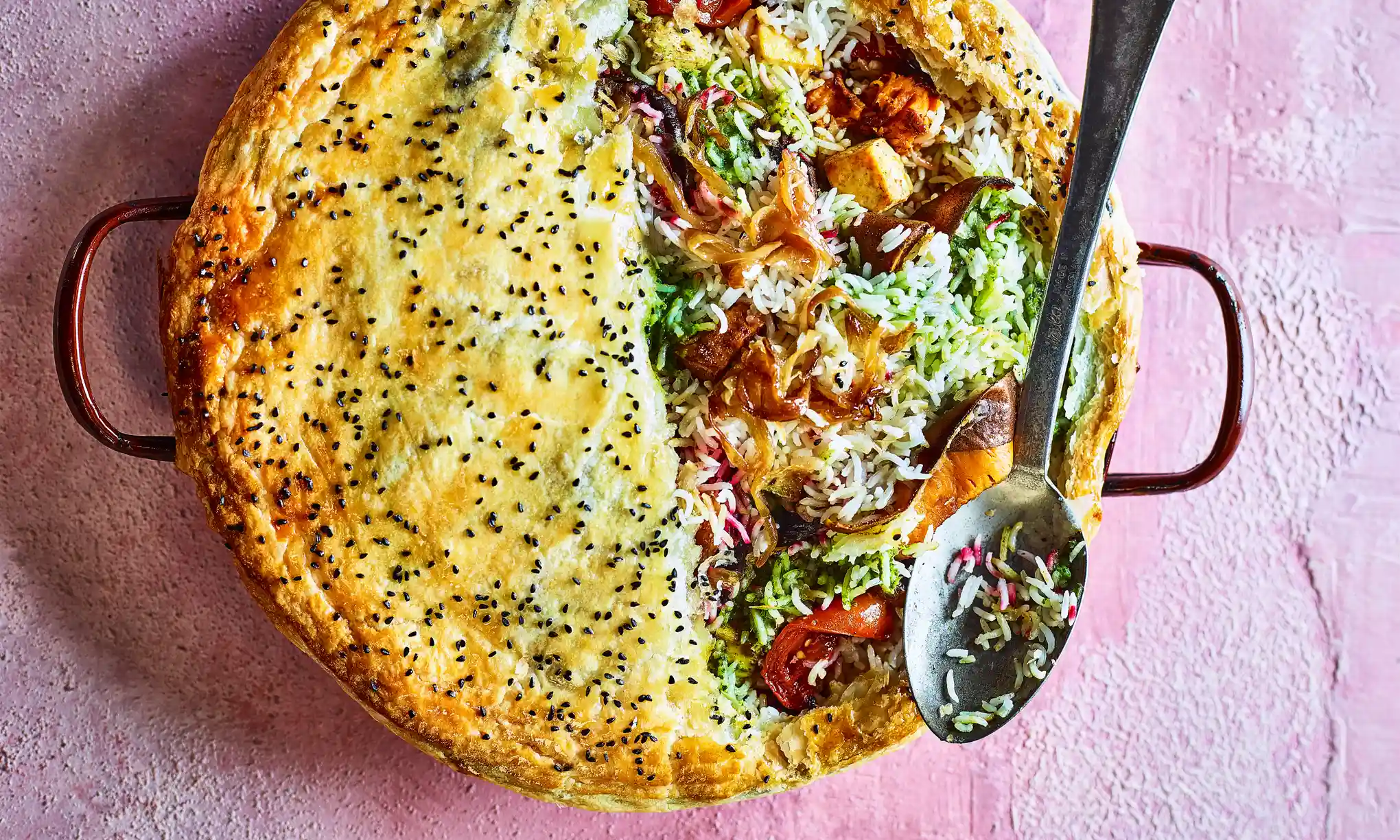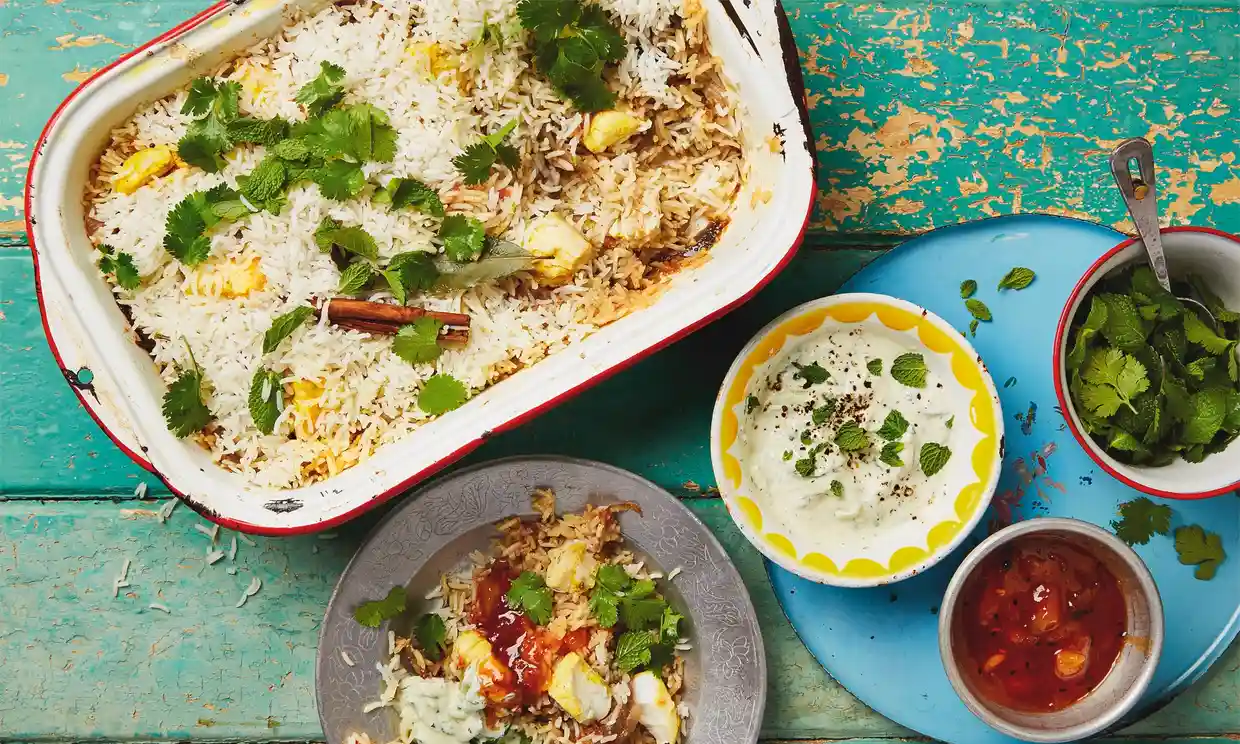"Essentially, it’s your favourite chicken curry (or vegetable or other protein of choice) buried under a mound of delicately spiced fluffy rice, all made in one pot." Nagi Maehashi/Recipe Tin Eats
I don't know how much the biryani on the left costs, but it looks expensive and comes from a Mumbai restaurant - so genuinely Indian. The one on the right is Lamb biryani from Coles Magazine and apparently will cost you $5.00 a serve. The Coles Magazine version is described as:
"Full of flavour and cooked in one pot, this comforting lamb biryani recipe is on the table in less than an hour. It’s light on your hip pocket, too."
However, at the other end of the spectrum, Madhur Jaffrey, in her essay on biryani in her book The Ultimate Curry Bible, says:
"Biryanis are the pinnacle of rice cookery for all of South Asia. We reserve them for festive occasions. They do take time to prepare. But as they are often one-dish meals and made only when guests are invited, the time is considered well spent. The most expensive seasonings such as saffron and cardamom are added unflinchingly." Madhur Jaffrey
Now whether one tastes better than the other I really couldn't say, but I am here to set out some alternatives and to explain how these things came to pass.

Not that Madhur Jaffrey, having said all that about how to do a 'proper' biryani, is against giving us a recipe for South-African chicken biryani which she says is included in the book because "I love it" and also because it fits into the "put-everything-in-and-no-regrets style of cooking." (The original recipe to which I have given you the link is from the website What's For Lunch Honey?) So even the high priestesses of Indian cooking can lower their standards. Christine Manfield too, who possibly has even higher standards, possibly because she is not Indian, talks of a 'real' Indian home cook who:
"taught me how to make white chicken biryani. It’s not colourful – it’s just chicken, rice and yoghurt, but my God, the flavour is so satisfying!"

Mind you, when she comes to give you a recipe for Saffron chicken biryani in her book Christine Manfield's Indian Cooking Class, you will find nothing so basic there, although it has to be said the final result is also not that colourful, however delicious.
So a little about origins. (see the map below) There is a minor dispute from the Southern Indians, but generally speaking most writers seem to think that it comes from Persia - and their Pulos, and that it came with the Moghuls who became the Moghlai rulers of the Indian subcontinent for centuries.
The original recipes often included
sweet and sour fruit, such as plums, were not very spicy in terms of heat, but were aromatic with spices such as cardamom and saffron. The meat and the rice were partially cooked and then layered in a pot, which was then sealed with pastry and cooked over embers. There was also a more complicated and difficult method whereby all of the ingredients were raw. How to get them to the same level of completion? Well the meat was marinaded to tenderise it somewhat, and the rice was very briefly parboiled. Madhur Jaffrey gives a version of this with a mildly amusing and lengthy preamble:

"If the South African biryani is the hot chick at the dance, this biryani is definitely the true princess at the ball, tall, pale and properly pedigreed, her tastefully chosen diamonds and emeralds glinting in the light of a hundred oil lamps.
The recipe as it was sent to me, begins 'With a silent prayer directed heavenwards, commence proceedings.' There is no need for the prayer. Once the pot with all the ingredients is sealed shut, no adjustments are possible. But there is no need to worry. The recipe is also foolproof.
The recipe I received called for meat from 'the hind leg of a castrated he-goat or khaki ka gosht'. Not having easy access to a butcher this obliging, I have used loin lamb chops."
Apologies the recipe is not online.
I almost forgot to mention the other origin story - brought by Arab traders to the southern parts of India. And certainly as you go south the biryani becomes spicier with Hyderabad being the most famous centre for this kind of biryani today.
So there you have two ways of making biryani - fundamentally the same but just raw or cooked meat and rice. Then you have Coles and others who really just cook everything in together, with varying degrees of sophistication as to flavourings - individually ground and chosen, or out of a jar.
Then there are the restaurants. I have a memory, which having checked with David, may well be a false memory, of Indian restaurants in the London of the sixties serving biryani as two separate dishes - a mix of rice and whatever you had ordered (chicken, beef, fish ...) on one plate and a dish of some kind of curry sauce on another. I cannot quite believe this, so would be grateful to hear if anyone else experienced the same thing. These days if you order a biryani you will get one dish of rice mixed with whatever - a tricky feat for a restaurant and so this is how they do it according to Madhur Jaffrey (and others).
"If an order for a chicken biryani came in, all the restaurant had to do was throw some oil and onions into a pan, perhaps add a few sliced green or red chillies, stir them about, then throw in some cooked chicken curry and then some cooked rice. This has passed for a restaurant biryani for decades and continues to do so today." Madhur Jaffrey
I wonder if they would pass this test from another somewhat snobby Indian chef?:
"When you’re confronted with a plateful of biryani, toss some on the floor and examine the grains. If even two grains stick together, your biryani has failed the test.” Shabnam Minwallah

There are literally thousands of recipes out there for meat biryanis, so I'll just offer one compromise recipe, simply called Biryani from Nagi Maehashi/Recipe Tin Eats. She says this is her seventh version and is foolproof, and it certainly looks pretty good. Interestingly she does not layer her meat and rice, just puts the rice on top of the bottom curry layer, pouring saffron laced water over the top and cooking, covered on top of the stove. So steamed rather than baked. It's pretty authentic in terms of spice mixes although she does suggest you can buy the crispy fried onions/shallots in the supermarket.
And there is also this very quick video, which is pretty helpful:
But what about the vegetarians amongst us? Well another purist Indian says:
“Don't be fooled by people who pass off vegetable pulao as biryani. There’s no such thing. It’s as much an oxymoron as chicken steak.” Rajayasree Sen
Which I find odd, considering the vast number of Indians who are vegetarians. But of course the western world doesn't care about these things, and there are almost more vegetable biryanis out there than meat ones - and some of them are very complicated. Here's a selection: Perfect vegetable biryani/Felicity Cloake; Biryani with saffron and golden veg/Anna Jones and Grand vegetarian biryani/Meera Sodha, who even does the pastry thing. Plus a Fish biryani -from Thomasina Miers

I couldn't leave the subject without checking out modern interpretations of the biryani concept - two from the Brits and one from Australia. Jamie Oliver somewhat surprisingly only has one biryani recipe on his website and that one is for leftovers - now how up to date is that? - Leftover lamb biryani - well why not? He also says:
"I’ve also given you a quick method for a crispy topping of nuts, herbs and spice – it’s not traditional by any means, but I’m having fun with it. See what’s in your cupboards and make it your own.”
Well why not, and I should note that the pure Christine Manfield also tops her chicken biryani with nuts, fried shallots and sultanas.
In Britain there is a prestigious chain (I think) of Indian restaurants called Dishoom and they have devised a Chicken berry Britannia (biryani) the recipe for which has been published on the delicious.uk website. Then our own Phoebe Wood for the Australian delicious. goes one step further with Lamb biryani rolls - a kind of sausage roll with a curried lamb mince and rice filling. Not biryani at all. I'm sure the purists would shudder.
And you can always have a go at the Coles recipe with a jar of Patak's chosen curry paste.












Comments